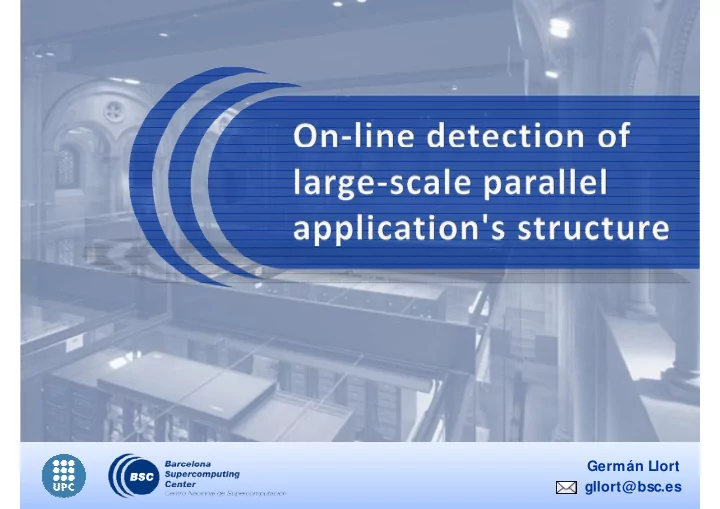

Germán Llort gllort@bsc.es
>10k processes + long runs = large traces Blind tracing is not an option Profilers also start presenting issues Can you even store the data? How patient are you? 2 IPDPS - Atlanta, April 2010
Past methodology: Filters driven by the expert • Get the whole trace • Summarize for a global view • Focus on a representative region Goal: Transfer the expertise to the run-time 3 IPDPS - Atlanta, April 2010
Traces of “100 Mb” • Best describe the application behavior • Trade-off: Maximize information / data ratio The challenge? • Intelligent selection of the information How? • On-line analysis framework – Decide at run-time what is most relevant 4 IPDPS - Atlanta, April 2010
Application tasks M PItrace attaches Data acquisition T 0 T 1 T n • MPItrace (BSC) – PMPI wrappers Data transmission • MRNet (U. of Wisconsin) Reduction Network – Scalable master / worker – Tree topology M RNet Front-end Data analysis • Clustering (BSC) Clustering Analysis – Find structure of computing regions 5 IPDPS - Atlanta, April 2010
Back-end threads Local trace buffers T 0 T 1 T n … BE threads blocked FE periodically collects data • Automatic / fixed interval Aggregate Broadcast • Reduction on tree data results Global analysis M RNet Front-end Propagate results Clustering Locally emit trace events Analysis 6 IPDPS - Atlanta, April 2010
Density-based clustering algorithm • J. Gonzalez, J. Gimenez, J. Labarta – IPDPS'09 “Automatic detection of parallel applications computation phases” Characterize structure of computing regions Using hardware counters data • Instructions + IPC – Complexity & Performance • Any other metric – i.e. L1, L2 cache misses 7 IPDPS - Atlanta, April 2010
Scatter Plot of Clustering Metrics Clusters Distribution Over Time Clusters Performance Code Linking 8 IPDPS - Atlanta, April 2010
Trigger clustering analysis periodically • Sequence of structure snapshots Compare subsequent clusterings • See changes in the application behavior Find a representative region • Most applications are highly iterative 9 IPDPS - Atlanta, April 2010
Compare 2 clusterings, cluster per cluster • Inscribe clusters into a rectangle • Match those that overlap with a 5% variance • Sum of the matched clusters cover the 85% of total computing time OK KO Stability = N equivalent clusterings “in-a-row” • Keep on looking for differences Gradually lower requisites if can not be met • Best possible region based on “seen” results 10 IPDPS - Atlanta, April 2010
60 Mb, 6 iterations 11 IPDPS - Atlanta, April 2010
Clustering time grows with the number of points • 5k pts 10 sec, 50k pts 10 min Sample a subset of data to cluster (SDBScan) • Space: Select a few processes. Full time sequence. • Time: Random sampling. Wide covering. Classify remaining data Nearest neighbor algorithm • – Reusing clustering structures 12 IPDPS - Atlanta, April 2010
All processes 25% random records 32 representatives 15% random records 16 representatives 10% random records 8 representatives + 15% random 75% less data Good quality 6s down from 2m Fast analysis 13 IPDPS - Atlanta, April 2010
Important trace size reductions Results before the application finishes Final trace is representative 14 IPDPS - Atlanta, April 2010
Compared vs. Profiles for the whole run • TAU Performance System (U. of Oregon) Same overall structure • Same relevant functions, Avg. HWC’s & Time % • Most measurement differences under 1% Full run profile (TAU) Trace segment (M PItrace) GROM ACS user functions % Time Kinstr Kcycles % Time Kinstr Kcycles do_nonbonded 23.72% 24,709 22,349 23.94% 24,700 22,533 solve_pme 10.47% 6,795 9,913 10.52% 6,776 9,898 gather_f_bsplines 5.69% 5,286 5,387 5.64% 5,248 5,302 15 IPDPS - Atlanta, April 2010
matched clusters ∑ % time 16 IPDPS - Atlanta, April 2010
Instructions imbalance IPC imbalance Study load balancing 17 IPDPS - Atlanta, April 2010
Initial development • All data centralized • Sampling, clustering & classification at front-end • Bad scaling at large processor counts >10k tasks • Sampling at leaves • Only put together the clustering set • Broadcast clustering results, classify at leaves 18 IPDPS - Atlanta, April 2010
On-line automatic analysis framework Identify structure and see how evolves Determine a representative region Detailed small trace + Periodic reports Reductions in the time dimension Scalable infrastructure supports other analyses Current work • Spectral analysis (M. Casas): Better delineate the traced region • Parallel clustering in the tree • Finer stability heuristic 19 IPDPS - Atlanta, April 2010
Recommend
More recommend